The great Southern novelist William Faulkner famously wrote, "The past is never dead. It's not even past." And so it was that in 2017 in Charlottesville, Virginia we seemed to be fighting the Civil War all over again. The battle there, and elsewhere, was over statues and monuments glorifying the heroes of the Confederacy. But as historian Sarah Gardner shows us these monuments, and the fights over them, have less to do with honoring the memory of the dead than with celebrating a society built on racial oppression.
According to news accounts, Jason Kessler, a former journalist and current member of the ultra-nationalist group the Proud Boys, planned a “Unite the Right” rally in his hometown of Charlottesville, Virginia, for Saturday, August 12, 2017. Members of the “alt-right” turned out to protest the removal of Charlottesville’s statue of Robert E. Lee, a decision that had been approved by City Council months earlier.
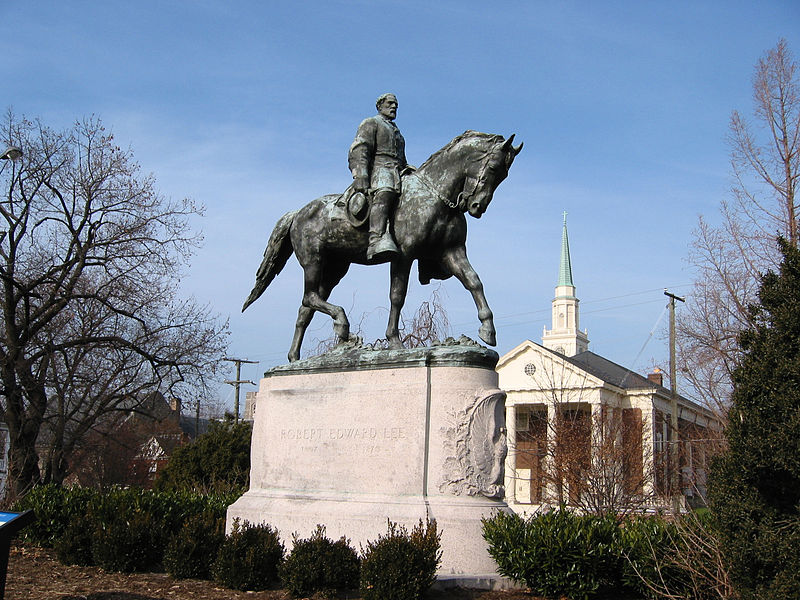
The night before, roughly 250 white supremacists congregated on the campus of the University of Virginia. One of the protest’s organizers ordered them to march in formation, “two by two,” to the statue of Thomas Jefferson. They carried lit torches and chanted white nationalist slogans.
At the Rotunda, they met about thirty UVA students who had locked arms around Jefferson’s statue “to face down the hundreds of torchbearers,” according to the Washington Post. The white nationalists circled the counter protesters as they continued to chant “white lives matter” and “blood and soil.”
Within moments, chaos ensued. “Shoves. Punches. Both groups spayed chemical irritants,” wrote a reporter for the Post. “Many marchers threw their torches toward the statue and the students.”
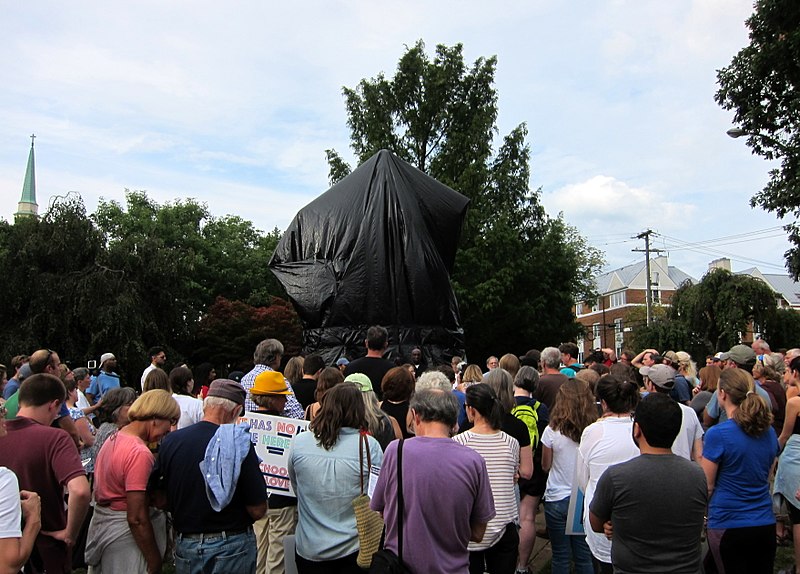
When police finally arrived, the violence had already begun. But the worst was yet to come.
Saturday’s rally was scheduled to start at noon, but by 8 a.m. Emancipation Park (formerly Lee Park) was filling up with white nationalists and counter-protesters. Skirmishes broke out. The police did not intervene.
Around 11 a.m., protesters marched to the park where they encountered counter-protesters who had formed a line to block off access. Protesters charged the line. Counter-protesters fought back. By 11:30, both the city of Charlottesville and Albemarle County had declared a state of emergency. Police ordered both groups to disperse.

Violence at the Unite the Right rally in Charlottesville, VA on August 12, 2017 (left). Members of the white supremacist organization National Vanguard at the rally (center). Protesters and counter-protesters clashing at the rally (right).
Sporadic fighting continued, but the rally had been stopped before it was even supposed to begin. It looked as if disaster had been averted.
But it hadn’t. Shortly before 2 p.m., a speeding car rammed into the counter-protesters, killing Heather Heyer and injuring 20 others. James Alex Fields, Jr., has been charged with second-degree murder along with other counts.
The violence in Charlottesville prompted yet another round of national self-scrutiny as Americans asked themselves once again: “How did we get to this point?”

Protesters at the Unite the Right rally in Charlottesville claiming that “diversity” leads to white genocide (top left). Protesters from various alt-right groups marching in Charlottesville (top right). Clashes between protesters and counter-protesters in Charlottesville (bottom left). Violence at the Unite the Right rally (bottom right).
The answer lies in understanding what these Confederate monuments really symbolize.
Over the past five months, historians have endeavored to demonstrate that something other than respectful recognition of a fallen foe was at play when Confederate monuments began popping up all over the South in the early decades of the 20th century. Many historians, in fact, have spent their careers demonstrating that Confederate commemoration tells us precious little about the Civil War and the men who fought it.
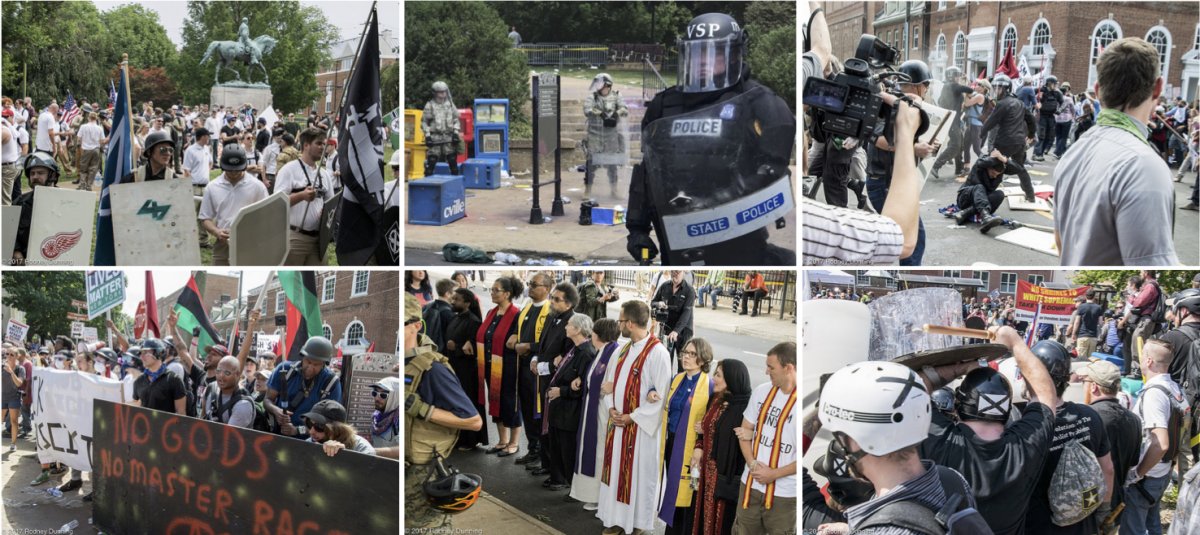
Assorted alt-right groups in front of Charlottesville’s statue to Robert E. Lee during the Unite the Right rally (top left). Virginia National Guard soldiers and Virginia State Police in the aftermath of the rally (top center). Protesters and counter-protesters clashing during the rally (top right). Counter-protesters at the rally (bottom left). Clergy and other counter-protesters linking arms against protesters during the rally (bottom center). Protesters and counter-protesters squaring off at the rally (bottom right).
Rather, the statues of Robert E. Lee, Stonewall Jackson, and the rest tell us a great deal about how a cultural industry worked in tandem with a political movement to legitimate white supremacy. Installing Confederate monuments coincided with the rise of Jim Crow, a legal, political, and cultural system that denied African Americans their place in the American polity.
In the years surrounding the turn of the 20th century, Southern states passed laws that segregated public spaces and disfranchised black voters. The Supreme Court upheld these laws, but it was not the only institution to blame for this betrayal of American liberty.
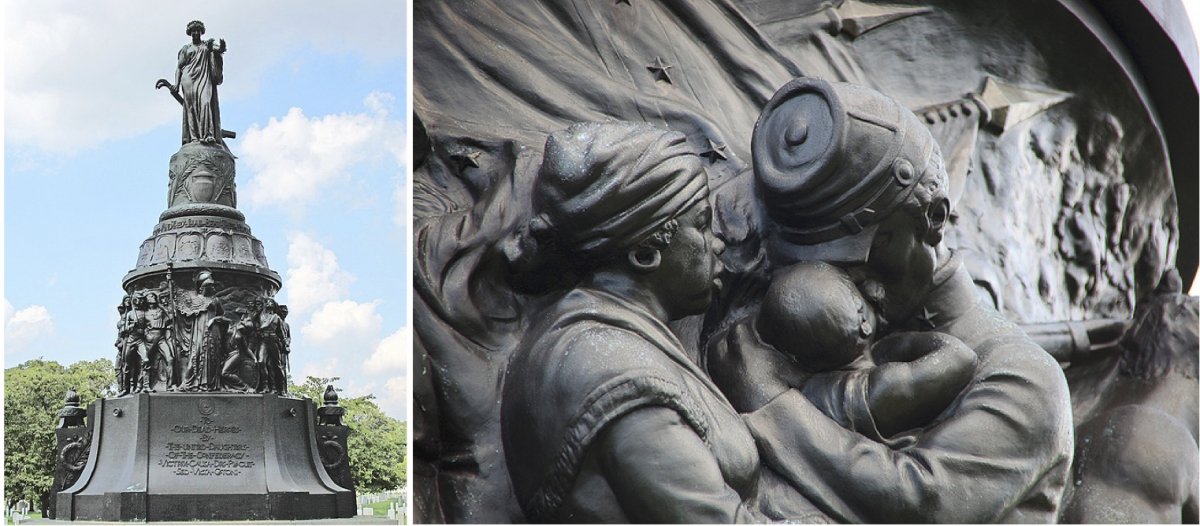
In 1900, Congress set aside a section of Arlington National Cemetery for Confederate war dead and on the 106th anniversary of the birth of Confederate President Jefferson Davis in 1914, President Woodrow Wilson dedicated a monument there. The female figure at the top represents “the South” and wears a crown of victory while another figure in the center also representing “the South” clutches a shield with the words “The Constitution” upon it (left). A frieze on the side of the monument depicting a crying “mammy” figure holding a white baby up to kiss the child’s father—a Confederate officer—goodbye (right).
A cultural edifice that included the news media, the film and music industries, and school curricula all helped normalize the racial order built on white supremacy and erased from public discussions the fact that slavery was the cause of the war.
History Written by the Vanquished
Confederate monument building was the culmination of a deliberate campaign to write the history of the Civil War from the Southern point of view. That memory industry began almost immediately after the Confederacy’s defeat.
This Southern version portrayed the Confederate cause as just and slavery as a benevolent institution. This narrative claimed the Civil War was a “brothers’ war,” and most of all, it insisted that the South fought to defend the Constitutional principle of “states’ rights” rather than slavery.
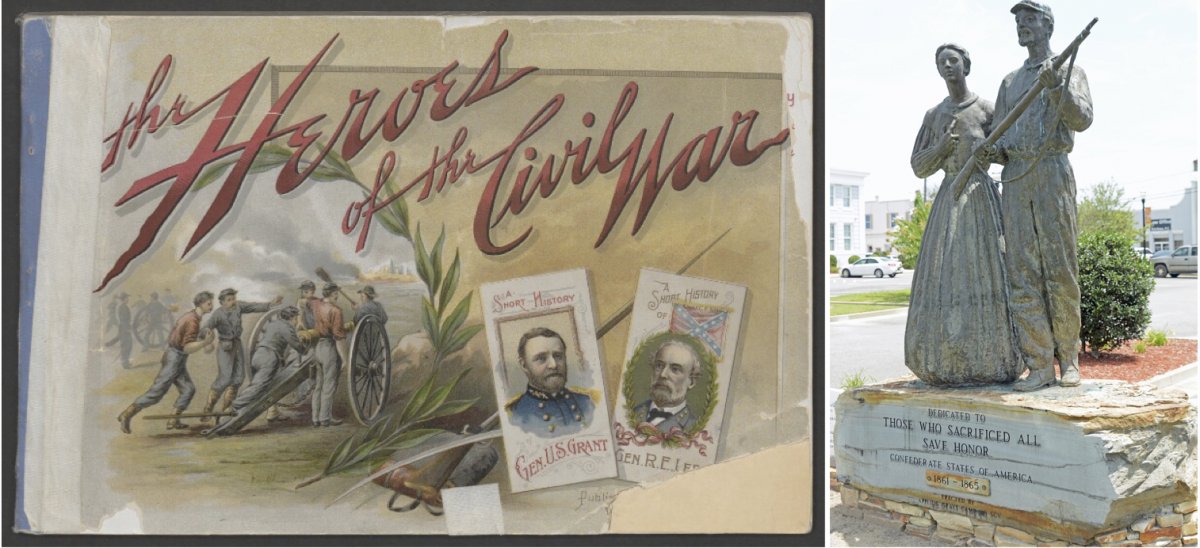
The Duke Tobacco Company of Durham, NC published heroic profiles of Confederate and Union figures in 1889 to advertise their cigarettes (left) [W. Duke, Sons & Co. Advertising Materials, David M. Rubenstein Rare Book & Manuscript Library, Duke University]. A monument to the sacrifices of Confederate soldiers in Baxley, GA originally on courthouse grounds but now on private property (right).
The move to erase the war’s genuine cause from national memory did not take long to emerge. But it was not accepted by everyone. Abolitionist and civil rights activist Frederick Douglass summarized the disturbing trend in “An Address at the Graves of the Unknown Dead,” delivered in Arlington, Virginia, in 1871.
“We are sometimes asked, in the name of patriotism, to forget the merits of this fearful struggle, and to remember, with equal admiration, those who struck at the nation's life, and those who struck to save it—those who fought for slavery, and those who fought for liberty and justice,” he said.
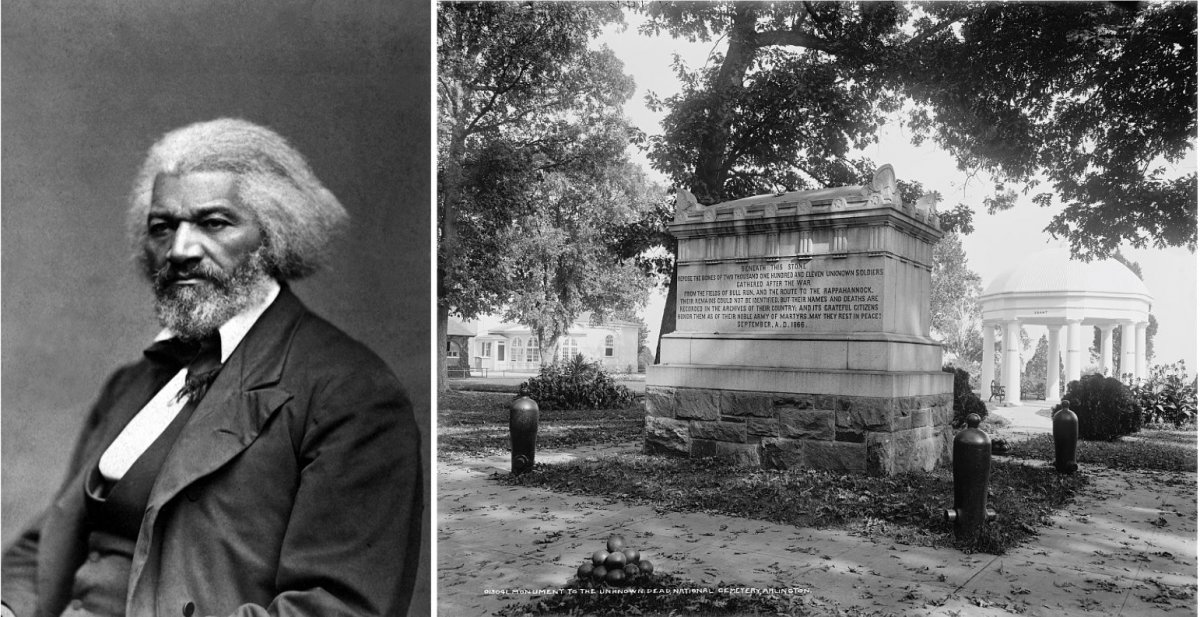
Frederick Douglass c.1895 (left). The Monument to the Unknown Dead at National Cemetery, Arlington (right).
Disclaiming any intent to peddle malice, he nonetheless vowed, “[M]ay my tongue cleave to the roof of my mouth, if I forget the difference between the parties to that bloody conflict.” For Douglass, forgetting the war made a mockery of Union sacrifice. “I say that, if this war is to be forgotten, I ask, in the name of all things sacred, what shall men remember?”
Six years later, at an address delivered in New York City on Decoration Day, Douglass decried the impetus to “forget and forgive.” The call to “strew flowers alike and lovingly, on rebel and on loyal graves” was simply absurd. “There was a right side and a wrong side in the late war, which no sentiment ought to cause us to forget,” he reminded his audience. No matter how noble-sounding Lincoln’s invocation of “malice toward none” and “charity for all,” Douglass intoned, “it is no part of our duty to confound right with wrong, or loyalty with treason.”
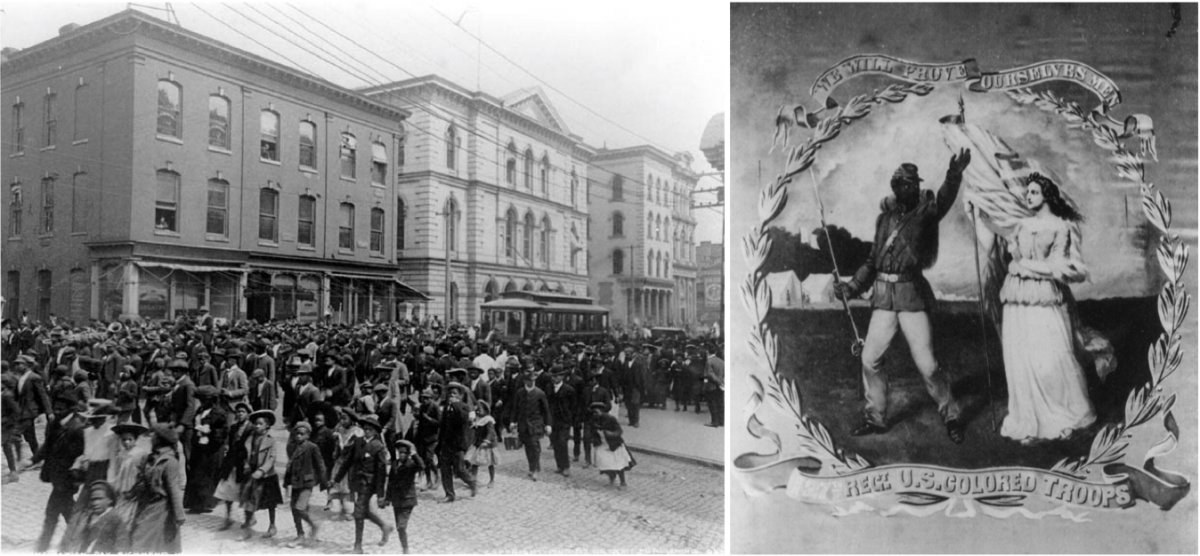
Despite the rewriting of the meaning of the Civil War in public memory, African Americans continued to uphold an emancipatory vision of the Civil War, such as in this 1905 Emancipation Day celebration in Richmond, VA (left). A banner for the U.S. Colored Troops proclaiming “We will prove ourselves men.” Few monuments, however, were dedicated to the sacrifices and accomplishments of black men who served in the Union Army and suffered higher casualty rates than white troops because of unequal conditions (right).
Douglass was ultimately on the losing end of this battle for historical memory. But at the time he delivered these two addresses, the massive drive to erect Confederate monuments in town squares across the South had yet to begin.
As long as African Americans and white Republicans held positions of power in Southern states, Confederate sympathizers were unable to erect monuments in public spaces. It took the North’s abandonment of Reconstruction, which allowed for the “redemption” of Southern states, before Confederate apologists could enshrine their views in public spaces.
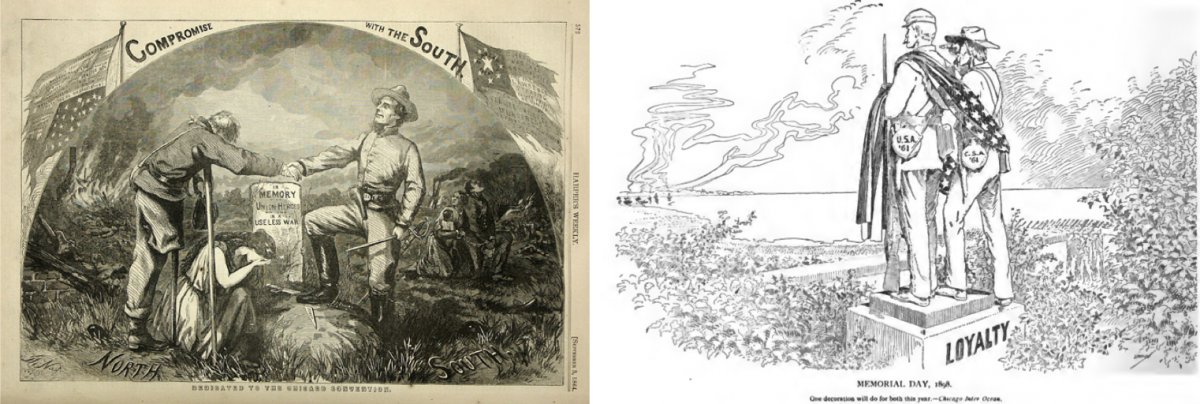
An 1864 illustration from Harper’s Weekly warning against compromising with the South and thereby traipsing over the graves of the Union dead (left). This 1898 cartoon during the U.S. war with Spain celebrated national reconciliation and “loyalty” with a caption reading “One decoration will do for both this year” in reference to the single flag draping both a Confederate and Union soldier (right).
Timing, Timing, Timing
Statues of Confederate heroes were not erected immediately after the war. They also did not go up during Reconstruction (1865-1877), a period during which the federal government, with greater or lesser success and enthusiasm, tried to make good on the emancipatory vision of Union victory (that without ending slavery and protecting the rights of African Americans, the war would have been fought in vain).
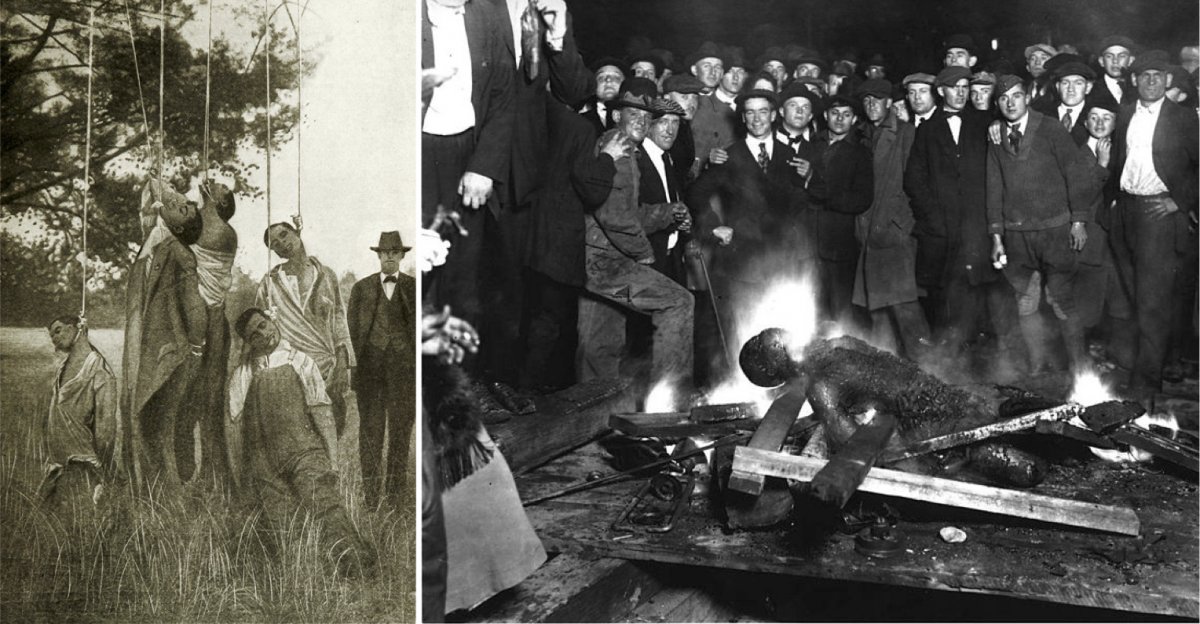
The bodies of six lynched African Americans in Lee County, GA in 1916 (left). White men posing around the mutilated and charred corpse of William Brown in Omaha, NE in 1919 (right).
Neither did the two decades after Reconstruction give rise to a flurry of Confederate monument building. It did, however, witness a rise in lynchings and other forms of racial violence as African Americans and their allies tried to build an interracial democracy.
More than 90 percent of Confederate monuments were erected after 1895, and much of this effort took place during the first two decades of the 20th century. By then, the “Lost Cause” myth, which described the Confederate cause in a positive and heroic light, had been firmly established in the national consciousness. Not coincidentally, the Supreme Court upheld segregation laws in its 1896 Plessy v. Ferguson decision and disfranchisement laws in its 1898 Williams v. Mississippi decision.
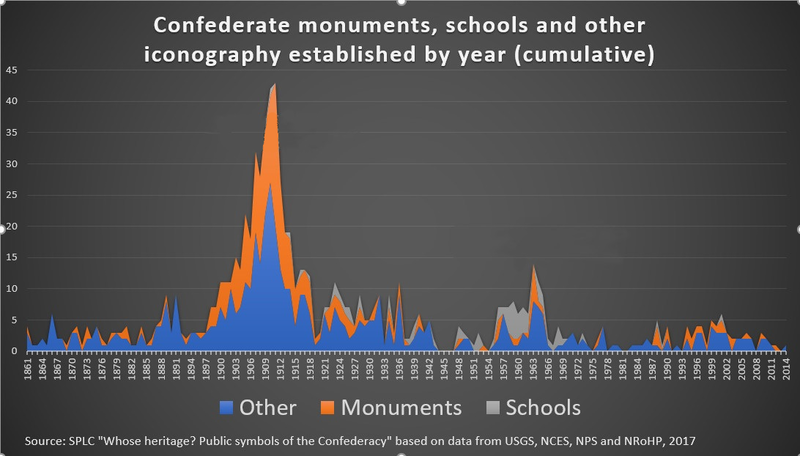
The purpose of these statues was not to honor the Confederate dead but to assert and celebrate white supremacy in the present.
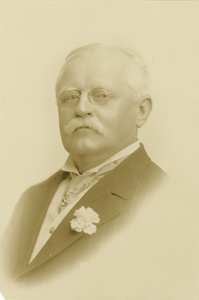 |
| Julian Carr, a North Carolina industrialist, philanthropist, and white supremacist. |
During the 1913 dedication of “Silent Sam,” a Confederate monument on the University of North Carolina’s campus, southern industrialist Julian Carr urged those in attendance to support the maintenance of white supremacy “with the same vigor that their Confederate ancestors had defended slavery.”
The present generation, I am persuaded, scarcely takes note of what the Confederate soldier meant to the welfare of the Anglo Saxon race during the four years immediately succeeding the war, when the facts are, that their courage and steadfastness saved the very life of the Anglo Saxon race in the South—When “the bottom rail was on top” all over the Southern states, and to-day, as a consequence the purest strain of the Anglo Saxon is to be found in the 13 Southern States—Praise God.
Carr celebrated the Ku Klux Klan and other terrorist organizations for saving the white race. His reference to “the purest strain” suggests that Carr meant something other than rescuing former Confederates from “Negro rule.” Instead, he meant that the Klan “protected” the virtue of southern white womanhood by lynching African American men, who, in the postwar South, were demonized as rapists.
Later, Carr told a personal anecdote about the part he played in terrifying the newly emancipated:
One hundred yards from where we stand, less than ninety days perhaps after my return from Appomattox, I horse-whipped a negro wench until her skirts hung in shreds, because upon the streets of this quiet village she had publicly insulted and maligned a Southern lady, and then rushed for protection to these University buildings where was stationed a garrison of 100 Federal soldiers. I performed the pleasing duty in the immediate presence of the entire garrison, and for thirty nights afterwards slept with a double-barrel shot gun under my head.
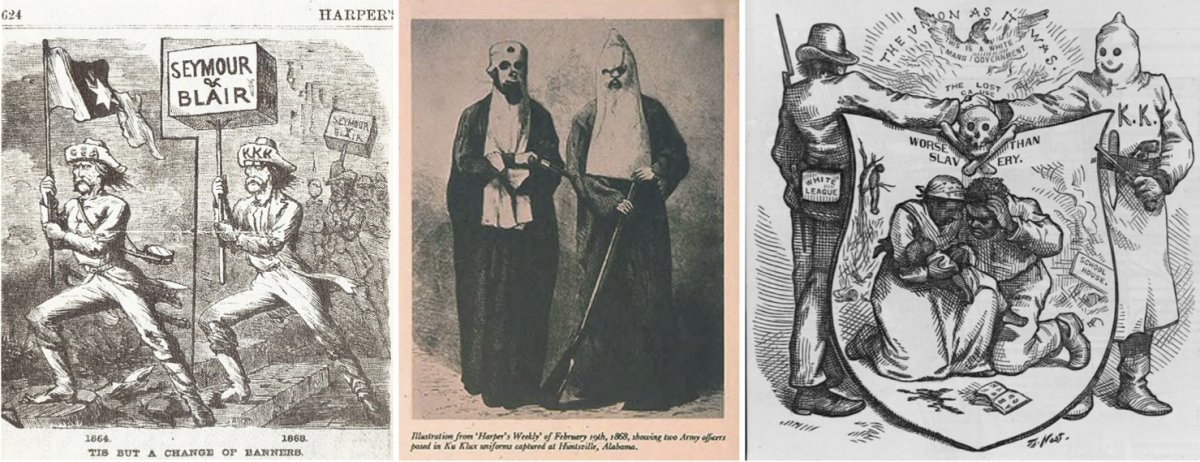
An 1868 political cartoon accusing the Democratic Party’s presidential candidates of relying on support from Ku Klux Klan members and Confederate traitors (left). Two former Confederate officers in Ku Klux Klan garb in Huntsville, AL in 1868 (center). An 1874 drawing by Thomas Nast of a man from the “White League”—a paramilitary organization to intimidate Republicans and black voters—shaking hands with a Ku Klux Klan member over a black couple and a lynched man in a fate depicted as “worse than slavery” (right).
As many historians have proven, Confederate memorials celebrated slavery, the South as a slave society, and white supremacy in general.
Charlottesville’s statue of Stonewall Jackson was installed in 1921, eight years after UNC erected the statue to Silent Sam. The city’s statue of Robert E. Lee was erected in 1924. Jackson’s statue rests atop “what was once a majority-black area known as McKee Row,” Slate recently recalled. Seven years earlier, the Albemarle County Board of Supervisors had “confiscated the land from its black residents and granted it to the city. The city justified its action by noting its concern about the ‘rowdy’ activity from McKee Row.”
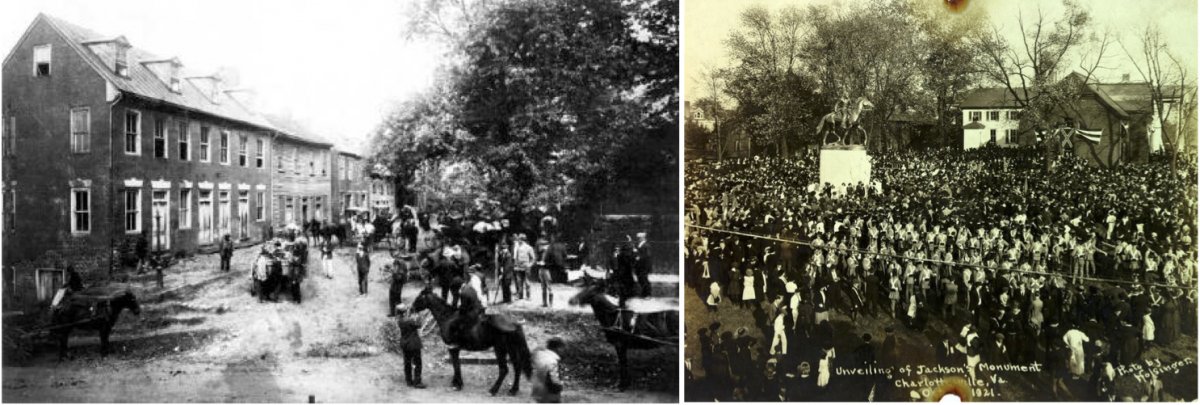
The “rowdy” neighborhood of McKee Row was demolished in 1919 to build Stonewall Jackson’s monument (left). The unveiling of the Stonewall Jackson Monument in Charlottesville, VA in 1921 (right). Both images courtesy of the Holsinger Studio Collection [#9862], Special Collections Department, University of Virginia Library.
The statue allowed Confederate apologists to engage in a kind of nostalgia for a bygone era. But its primary function was to intimidate the African American community. To emphasize the point, the statue was erected over the former location of the Charlottesville jail.
The Lee statue abutted what was then a vibrant African American neighborhood, Vinegar Hill, which the city razed in the 1960s as part of an urban renewal project. The only marker of this former community is a small plaque reading, “Today Vinegar Hill is just a memory.” Indeed, it is a memory of an African American past replaced by a commemoration of the Confederacy.

A small plaque remembering the once-vibrant black neighborhood of Vinegar Hill in Charlottesville, VA (left). The city's monument to Robert E. Lee in the 1920s (right).
The Second Wave of Confederate Monuments
If the first generation of Confederate statues crowned the triumph of the Jim Crow South, it is not surprising that a second generation of these monuments appeared when Jim Crow came under attack.
Baltimore erected its joint statue to Jackson and Lee in 1948. It is worth remembering that Maryland did not join the Confederacy, so the city’s decision to place a statue of two of the rebellion’s most famous generals might seem odd. After all, the United States had just fought and won a world war for democracy.
Baltimore’s proximity to Washington, D.C. suggests that the timing of the statue’s installation could be related to the federal government’s push to broaden the scope of civil rights protections.
In 1946, President Harry S. Truman had established a presidential commission to investigate the status of civil rights in America. The commission issued its report, “To Secure these Rights,” in late 1947. It made a number of recommendations, including abolishing the poll tax, establishing a permanent fair employment practices commission, and passing a federal anti-lynching law.
Although Congress refused to move on the report’s findings, Truman did issue two executive orders based on the committee’s findings. Executive Order 9980 desegregated the federal work force and Executive Order 9981 desegregated the armed forces.
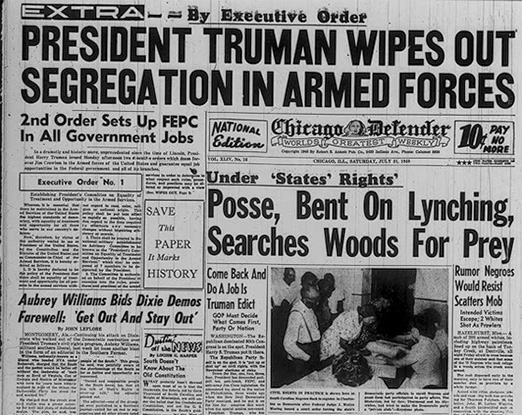
The timing also coincided with the formation in 1948 of the segregationist States’ Rights Party, also known as the Dixiecrats, led by U.S. Senator Strom Thurmond (SC).
Its platform pledged to defend segregation “and the racial integrity of each race.” It opposed “the elimination of segregation, the repeal of miscegenation laws, [and] the control of private employment by Federal bureaucrats called for by the misnamed civil rights program.” Dixiecrats favored “home-rule, local self-government, and a minimum interference with individual rights.”
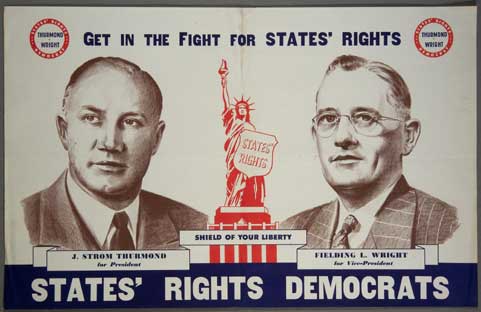
The Dixiecrats equated the abolition of Jim Crow legislation with the forces of totalitarianism as they played on Cold War fears. The specter of a centralized police state loomed large as the Soviet Union expanded across Europe.
The logic behind building that joint Jackson-Lee statue in a state that had remained loyal to the Union is transparent. The statue memorialized no one, but rather, advanced a racial ideology that undergirded a system designed to keep the nation unequal and divided.
Nothing illustrates the ideological connection between these two generations of monuments better than Stone Mountain in Georgia.
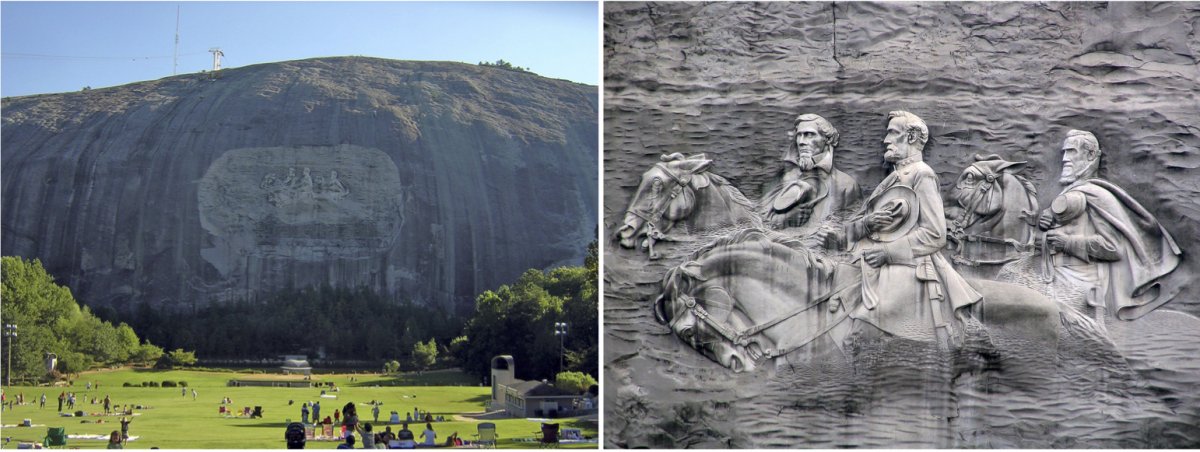
A view of the carvings on Stone Mountain, the visitor center, and the surrounding park (left). A close-up of the carving on Stone Mountain featuring Jefferson Davis, Robert E. Lee, Stonewall Jackson, and their favorite horses (right).
The silhouettes of Jefferson Davis, Robert E. Lee, and Stonewall Jackson carved onto Stone Mountain were originally planned in 1915 by one of the founders of the United Daughters of the Confederacy. The UDC commissioned Gutzon Borglam, better known for his work at Mount Rushmore, and he began carving the following year. Borglam abandoned his work on Stone Mountain in the mid-1920s and it remained unfinished until the 1960s.
The project was revived in 1963 when the civil rights movement was gathering momentum. This was the same year NAACP activist Medgar Evers was assassinated, the same year that John F. Kennedy promised the nation civil rights legislation, and the same year that Martin Luther King, Jr., delivered his “I Have a Dream Speech” at the March on Washington.
Carving resumed in 1964 and was finally completed in 1972. The carvings are larger than Mount Rushmore: 76 by 158 feet tall, 42 feet deep. The entire surface runs more than 1.5 acres, and the carving stands 400 feet above ground level.
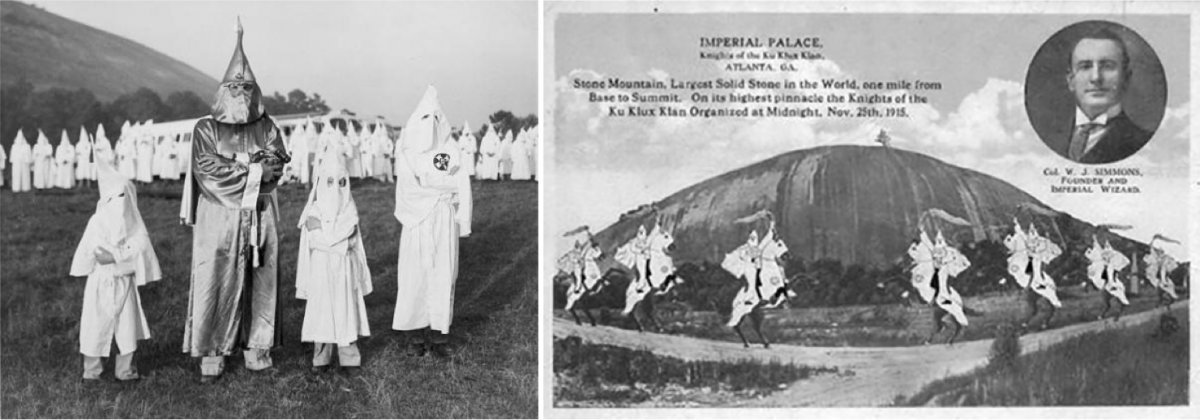
A Ku Klux Klan initiation ceremony at Stone Mountain in 1948 with Dr. Samuel Green, a Grand Dragon of the Klan, and children in Klan robes and hoods around him (left). A postcard advertising Stone Mountain as the Imperial Palace of the Knights of the Ku Klux Klan and the place of its (re)organization in 1915 (right).
Stone Mountain has nothing to do with honoring the Confederate dead of the 1860s and everything to do with asserting white supremacy and defying civil rights advances in the 1960s. Originally planned as part of the revitalization of the Ku Klux Klan in the 1910s, the project was restarted at the high point of the modern Civil Rights movement and completed as the Black Power movement exploded.
Monuments and other public markers, such as street names or the names of schools, play an oversized role in mythmaking, precisely because they are public and are officially sanctioned (even when they lose popular support). They bear an official imprimatur.
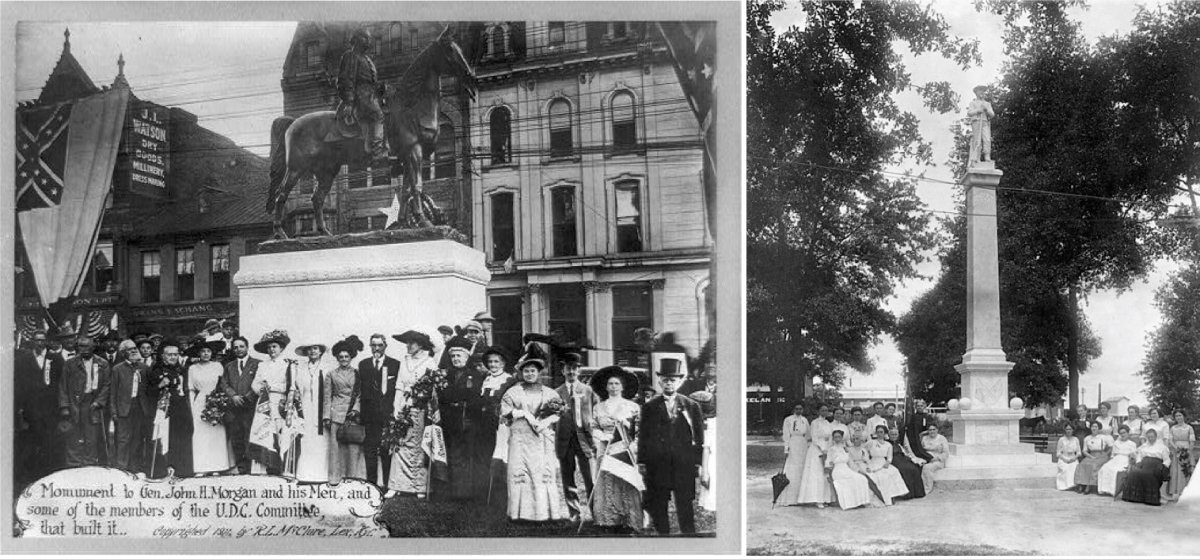
Despite Kentucky remaining in the Union, in 1911 members of the United Daughters of the Confederacy dedicated this monument to Kentucky native and Confederate General John H. Morgan and his 2nd Kentucky Cavalry Regiment (left). Members of the United Daughters of the Confederacy around the monument they sponsored in Lakeland, FL in 1915 (right).
On one level, the maintenance of Confederate monuments and other markers signifies to residents (as well as to tourists) that a city or state condones the cause for which Confederates fought. On another level, it signals that a municipality or a state legislature does not find it problematic to enshrine those who took up arms against the U.S. government.
The messages of these government monuments were reinforced and amplified by advertisements, toys, illustrations, short stories, novels, films, and radio shows that all played a role in Confederate mythologizing.
Who Is In and Who Is Out
There is a reason why some Confederates are honored and others are not. That reason also has nothing to do with bravery, honor, or battlefield heroics. It does, however, have everything to do with post-Civil War politics.
The Southern landscape is not littered with monuments to General William Mahone, for example. An able divisional commander, Mahone had the kind of military career that Confederate apologists cheered, filled with military prowess and battlefield heroism. Active in Virginia politics after the war, he served as a U.S. senator in the 1880s.
Yet he has been virtually erased from the Confederate past because he did not serve the needs of Jim Crow’s architects and its subsequent defenders. If Confederate propagandists found Mahone’s military career unblemished, they could not say the same about his postwar political career.
Mahone was criticized and defamed because he organized and led a successful interracial political alliance that threatened the stranglehold white conservatives held on the post-Reconstruction-era South. Though short-lived, Mahone’s coalition promoted the advancement and protection of black political and civil rights. For those sins he was written out of Confederate memorializing.
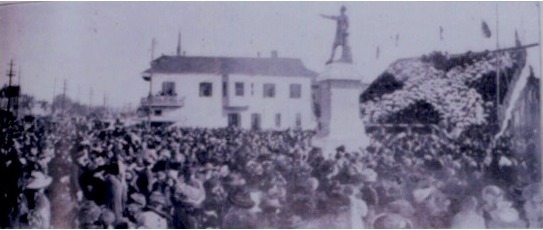
Indeed, the politics of forgetting proved as crucial as the politics of remembering. To create a usable past—one that saw Jim Crow as a logical outgrowth of the post-Reconstruction period—white supremacists had to wipe clean much of the historical record.
Not all monuments depicted Confederate soldiers. Some honored white conservatives who died after the Civil War defending white supremacy.
Such a monument was erected in 1920 to memorialize the 1873 Colfax Massacre (then called “riot”) during which some 150 African American men were murdered. The massacre occurred when a coalition group of Democrats and conservative Republicans who had defected from their party refused to accept Louisiana’s election returns of 1872.

The base of an obelisk built in 1921 in Colfax, LA (left) [Image courtesty of Robin Cole-Jett]. A depiction of African Americans gathering the estimated 150 killed after the Colfax Massacre (center). A historical marker put up in 1950 describing the Colfax Massacre as a riot and terming the conservative white takeover “the end of carpetbag misrule” (right).
Rumors of violence had circulated for weeks before the massacre. Freedmen occupied the Colfax Courthouse, using it as a garrison. The surrounding served as their training ground. Armed whites threatened to retake the Courthouse. The standoff lasted three weeks. Then, on Easter Sunday 1873, the white men attacked. The former slaves surrendered, but many were later shot in the backs of their heads.
In 1920, at the height of Confederate monument-building, a plaque was put up to commemorate the “Colfax Riot.” It read: “Erected to the memory of the heroes, Stephen Decatur Parish, James West Hadnot, Sidney Harris who fell in the Colfax Riot fighting for white supremacy April 13, 1873.”
In 1950, a new marker was erected. Although the wording was changed, the sentiment remained: “On this site occurred the Colfax Riot, in which three white men and 150 negroes were slain. This event on April 13, 1873, marked the end of carpetbag misrule in the South.” By claiming that Reconstruction-era government was illegitimate, the 1950 marker championed conservative white rule.
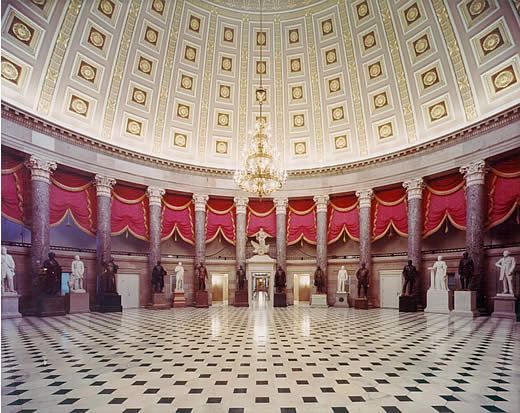
“You/Jews Will Not Replace Us …”
The violence in Charlottesville has ratcheted up the stakes in ways perhaps unthinkable in our recent past. Although the presence of the torch-bearing marchers in Charlottesville might shock us, it should not. The one thing the white supremacists and the neo-Nazis who protested the removal of the Lee statue in Charlottesville did get right was the historical connection between white supremacy and Confederate monuments.
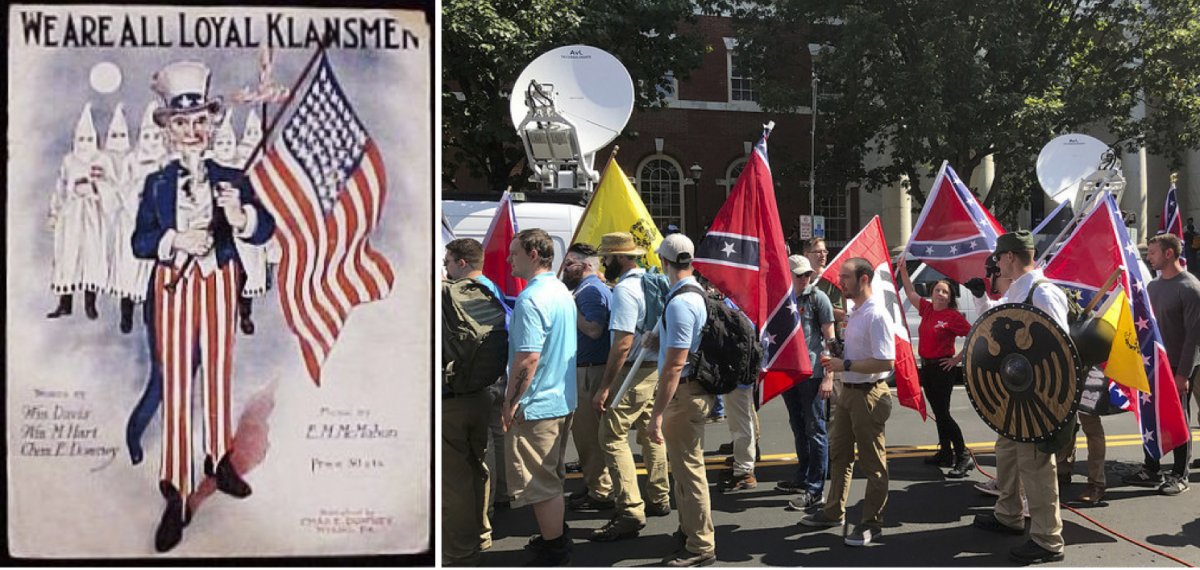
Sheet music for the song “We Are All Loyal Klansmen” from 1923 (left). Protesters at the Unite the Right rally in Charlottesville with marchers carrying Confederate, Nazi, and “Don’t Tread on Me” flags (right).
There is also a clear connection between white supremacy and fascism. The Nazi regime repeatedly praised the slaveholding regime of the Old South, and used Jim Crow statutes as inspiration for their own Nuremberg Laws .
The alliance between neo-Confederates and neo-Nazis that surfaced in Charlottesville, therefore, is also rooted in an historical parallel.

Members of Aryan Nations, a white supremacist group founded in the 1970s, posted praise for Dylann Roof after his mass-shooting at a black church in 2015 (left). Roof—a self-proclaimed white supremacist and neo-Nazi—killed nine African Americans during a prayer meeting at Emanuel African Methodist Episcopal Church in Charlotte, SC (center). Founded in 1816, Emanuel African Methodist Episcopal Church is the oldest African Methodist Episcopal church in the South (right).
Critics have increasingly attacked the continued toleration of Confederate monuments in recent years, prompted by Dylann Roof’s 2015 terrorist attack at Emanuel African Methodist Episcopal Church in Charleston, South Carolina, which killed nine African Americans.
Earlier this spring, the City of New Orleans removed statues of Robert E. Lee at Lee Circle and of Jefferson Davis. The city was acting on a 6-1 city council vote to dismantle the statues that had taken place some 18 months earlier. The removals prompted stern criticism. One Mississippi politician opined that those behind Lee statue’s removal should be “lynched.”
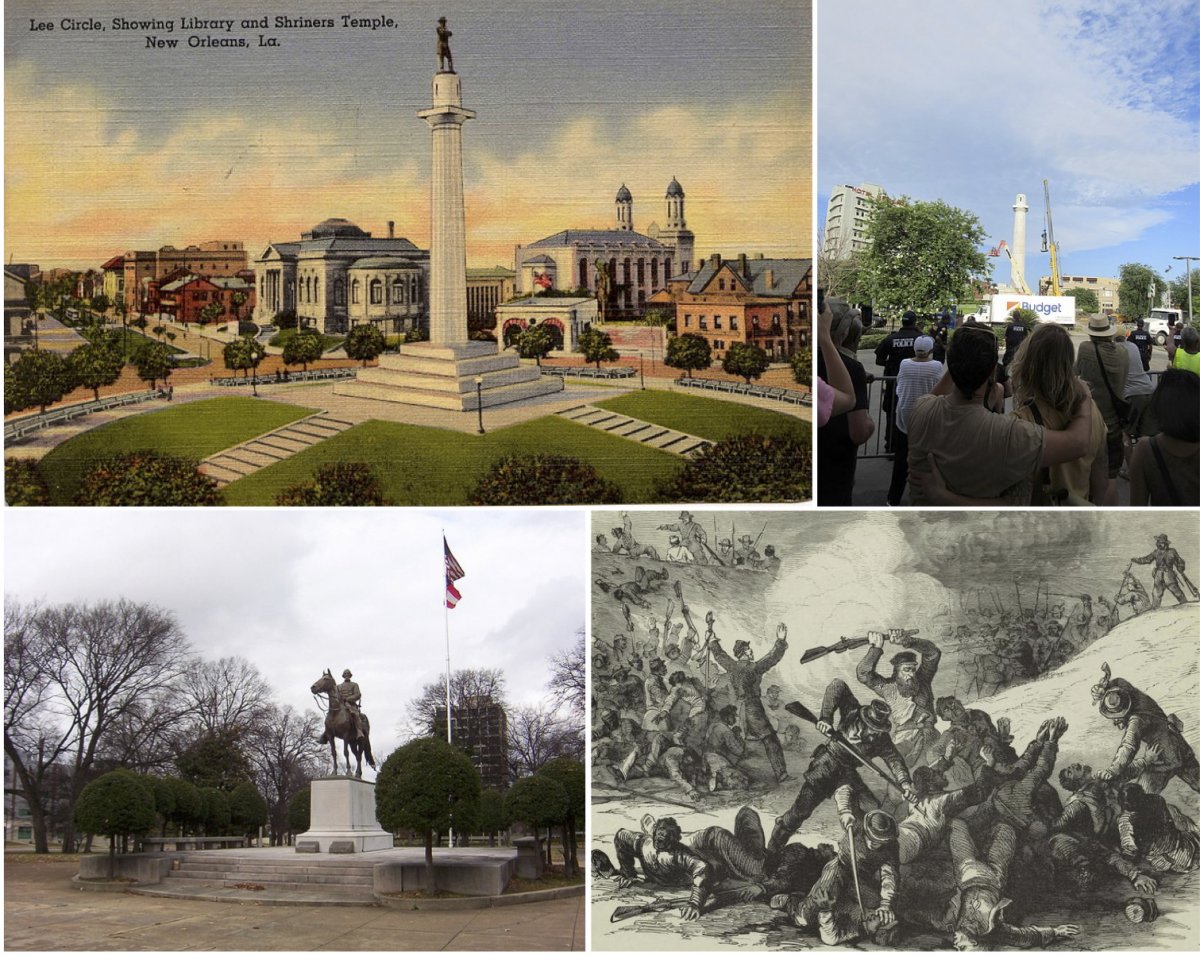
A postcard from the 1920s or 1930s of Lee Circle in New Orleans, LA (top left). A crowd watching the removal of the statue of Robert E. Lee from atop his sixty foot pedestal in 2017 (top right). A memorial to Nathan Bedford Forrest in Memphis, TN before it removal in 2017 (bottom left). An 1864 depiction of the Fort Pillow Massacre in which Confederate troops under the command of General Forrest slaughtered over 300 black Union soldiers after they had surrendered (bottom right).
Four days after the protests in Charlottesville, the mayor of Baltimore ordered Confederate monuments removed, with no public notice, in the middle of the night. He did so “in the interest of my city.”
And last month, the city of Memphis voted to sell two city parks with Confederate monuments, including one of Nathan Bedford Forrest. Forrest was a brilliant Confederate military leader. He had also made a fortune as a slave trader before the war and he went on to be an early leader of the Ku Klux Klan after it. Within an hour of after the city council’s vote, cranes were poised to tear down the statues.
The legal transfer of city property to a non-profit organization allowed Memphis to avoid a state law that prohibits the “removal, relocation or renaming of public memorials on public property,” according to the New York Times. Memphis’s mayor acknowledged the violent protests in Charlottesville in prompting municipalities to reevaluate the presence of Confederate monuments within their boundaries. We can expect more statues to come down.

The monument to Jefferson Davis in New Orleans, LA (left). Protesters occupied the former cite of the Davis monument for several days after its removal in 2017, but once they left someone placed an unofficial replacement monument on the platform that once held a statue of the President of the Confederacy (right).
But we can also expect more to go up.
Recently, the Los Angeles Times reported an increase in Confederate monument installations on private land. One such monument went up in Orange, Texas. The monument might be on private property, but it is clearly visible from public spaces, such as the interstate highway. According to the report, the statue looms over Martin Luther King, Jr., Drive.

And so here we are.
The monument in Orange is not a singular object. According to the Southern Poverty Law Center, more than 30 Confederate monuments or symbols have been dedicated or rededicated since 2000.
The nation remains divided because of the stories we tell ourselves. As long as we as a nation refuse to acknowledge the hateful symbolism and political aspirations of these monuments, we will live with the repercussions.
Many of the op-eds and journalistic pieces consulted for this article can be found here: http://cwmemory.com/civilwarmemorysyllabus/
William Blair, Cities of the Dead: Contesting the Memory of the Civil War in the South, 1865-1914 . (Chapel Hill: University of North Carolina Press, 2004).
David W. Blight, Race and Reunion: The Civil War in American Memory (Cambridge, Mass: The Belknap Press of Harvard University Press, 2001).
W. Fitzhugh Brundage, The Southern Past: A Clash of Race and Memory (Cambridge, Mass: The Belknap Press of Harvard University Press, 2008).
Karen L. Cox, Dixie’s Daughters: The United Daughters of the Confederacy and the Preservation of Confederate Culture (Gainesville, Florida: University of Florida Press, 2003).
Karen L. Cox, Dreaming of Dixie: How the South Was Created in American Popular Culture (Chapel Hill: University of North Carolina Press, 2011).
Jane Dailey, Before Jim Crow: The Politics of Race in Post Emancipation Virginia (Chapel Hill: University of North Carolina Press, 2000).
Alice Fahs and Joan Waugh, eds., The Memory of the Civil War in American Culture (Chapel Hill: University of North Carolina Press, 2004).
Caroline E. Janney, Burying the Dead but Not the Past: Ladies Memorial Associations and the Lost Cause (Chapel Hill: University of North Carolina Press, 2008).
Caroline E. Janney, Remembering the Civil War: Reunion and the Limits of Reconciliation (Chapel Hill: University of North Carolina Press, 2013.
Cynthia Mills and Pamela H. Simpson, eds., Monuments to the Lost Cause: Women, Art, and the Landscapes of Southern Memory (Knoxville, Tenn: University of Tennessee Press, 2003).
Kirk Savage, Standing Soldiers, Kneeling Slaves: Race, War, and Monument in Nineteenth-Century America (Princeton: Princeton University Press, 1997).
Nina Silber, The Romance of Reunion: Northerners and the South, 1865-1900 (Chapel Hill: University of North Carolina Press, 1993).
Chad E. Williams, Kidada E. Williams, and Keisha N. Blain, eds., Charleston Syllabus: Readings on Race, Racism, and Racial Violence (Athens: University of Georgia Press, 2016).

